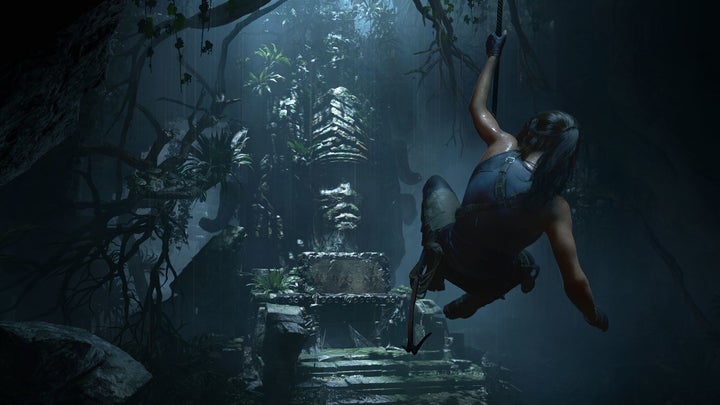
The latest Tomb Raider game will imminently be upon us, completing a rebooted trilogy that began in 2013. It promises another adrenaline-fuelled, if somewhat darker, ride. The trailers show a lightly muscled and appropriately attired Croft taking down enemies and swinging over chasms. In one scene she rises out of water while the world is apparently in flames. It seems fitting. After all, this is the game in which the younger Lara Croft is forged into the tomb raider she’s destined to be.
It’s got me thinking about my own journey with the game, seeing as I’ve played every one (including the jittery co-op versions), and how/if Croft fits in the improving feminist landscape. Short version: yes, she’s always been a feminist icon and, to me, her big boobs were a highlight. Allow me to expand on that.
Let’s start with the fact that a woman wrote her to begin with. Vicky Arnold wrote the first three Tomb Raiders and the rebooted version has been written by two further female, award-winning writers: Rhianna Pratchett, daughter of Terry, and a successful games writer in her own right, and Jill Murray (writer of Assassin’s Creed) who takes up the mantle of this instalment.
This team brought a lead female games character smack bang into a highly male-oriented world - and she was sharp, strong, fearless, and extremely independent. There was no obvious male love interest and Lara was educated, had her own wealth and possessed great mental acumen and physical strength, capped off with balletic grace. What a gal.
It’s important to acknowledge that when Croft first burst onto the scene female characters were seen as trophies, rather than heroines in their own right. Aside from the fighting femmes of Tekken, there were precious few, if any, kick-ass gals in the gaming arena. Croft was my first female lead and it meant a great deal.
Where she falls short for many was that she also had gravity-defying, humongous breasts. Putting aside the fact that most characters, male, female or other, in the gaming world are exaggerated and usually have a trademark feature, this still touched a nerve. However, I considered those undeniable mammaries to be a bonus.
You see, Lara Croft’s big boobed-ness contributed to my own body confidence. “Blessed” with over-generous knockers at an early age, I was excruciatingly self-conscious. I wanted to do what I’d always done: run, jump and hang upside down when occasion called for it, but it was deemed unseemly to prance around with such accoutrements.
I was 17 in 1996 when the first Tomb Raider game appeared and I’d been crying out for busty females who were fit and adventurous. I took my role models where I could find them, even if they were fictional, thus Xena: Warrior Princess and Lara Croft became my poster pin-ups: beauties with brains, who could fight and somersault through the air even with their big jubblies.
Encouraged by the popularity of Croft, Xena and even Geri Halliwell, my teen self ditched the baggy jumpers and donned more form-fitting clothes. I purchased a decent sports bra, worked out and stood a little straighter. I unfurled from the crippling self-consciousness and accepted (more or less) what nature had given me.
The new Lara Croft is just as strong, brave and capable as she was before but this time she’s bricking it as she’s thrown into chaos and violence. It’s a refreshing change that was initially jarring as the Croft of old was cool, bordering on psychotic. Pratchett gave this one vulnerability, humanity and depth. She’s still got curves but those assets have been taken down a cup size or ten.
I might miss the fact that Croft no longer bounces all over the screen in more ways than one, but I think the reboot is promising. It’s more modern and the marketing has evolved accordingly. The Tomb Raider franchise has shaped the gaming industry, endured for 22 years and has a legion of fans. Ms Lara Croft is still an icon and has paved the way for other leading female characters. Long may she continue.
